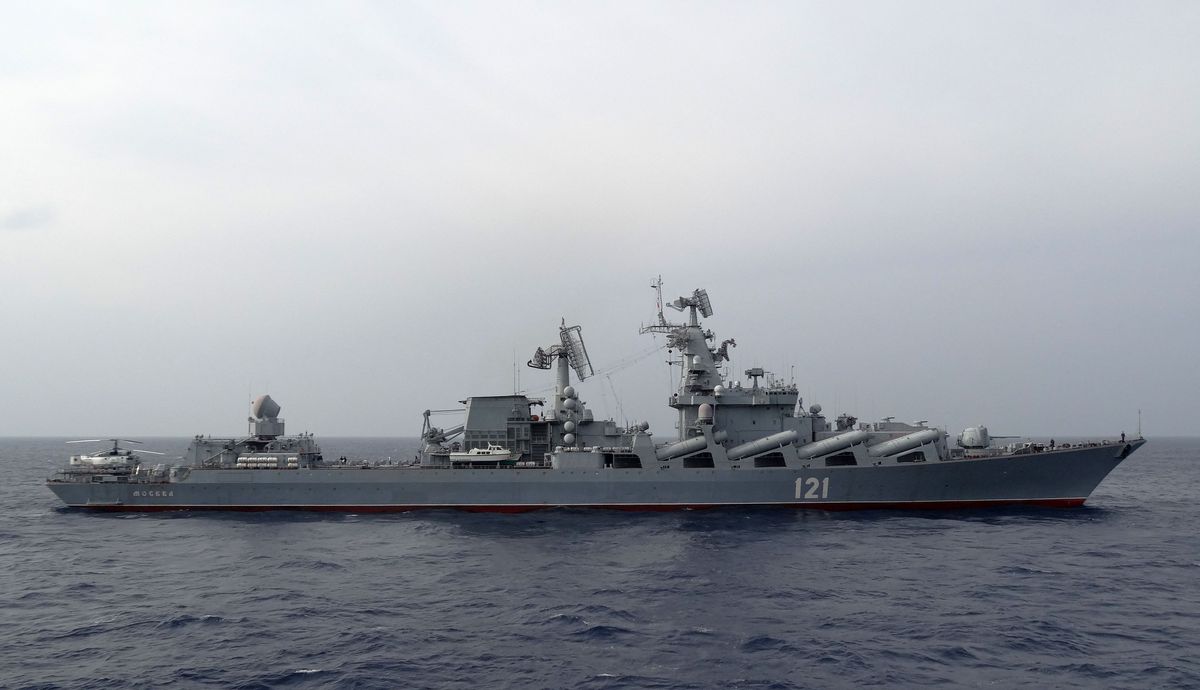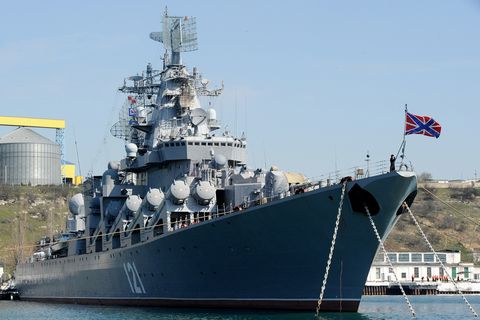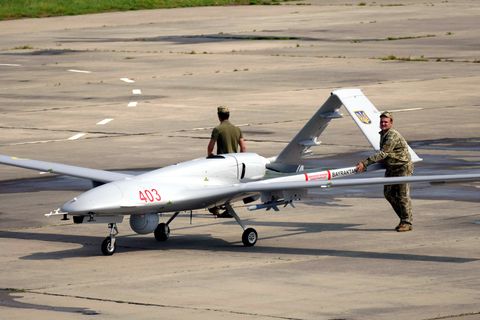KYLE MIZOKAMI

Back in April, two Ukrainian anti-ship missiles attacked and ultimately sunk the flagship of Russia’s Black Sea Fleet, Moskva, in a serious blow to Moscow. For months, no one knew exactly how Ukrainian forces pulled it off—until now.
According to an account from the Ukrainian news outlet Pravda, the operation relied on the fortuitous appearance of an unusual weather phenomenon known as “ducting.” As a result, radars defending the country’s coastline could see much farther than usual, allowing coastal defenders to launch a lethal missile attack.
If true, this helps explain how a country with no navy to speak of managed to sink one of the largest surface warships in the world. So to get to the bottom of it, we recruited a radar expert.
A Virtually Untouchable Ship

The Russian Navy flagship missile cruiser Moskva remains docked in the bay of the Crimean city of Sevastopolon, March 30, 2014.OLGA MALTSEVA//Getty Images
In the lead-up to Russia’s invasion of Ukraine, the Russian Navy gathered three of its largest ships, Slava-class guided missile cruisers in and near the Black Sea. That included Moskva, Russia’s flagship in the Black Sea.
Russia had gathered its warships to ensure naval supremacy, and to assist in an amphibious landing against Ukraine’s southern coastline. The landing never actually took place and the assembled fleet gradually scattered. Moskva stuck around and, according to Western estimates at the time, was loitering approximately 60–65 miles off the coast of the city of Odessa.
In modern warfare, 60–65 miles is not far, but Moskva was virtually untouchable against Ukraine’s weak air and naval forces. Ukraine had only one large surface warship, the Hetman Sahaidachny, and the frigate was scuttled early in the war to avoid capture by advancing Russian forces. Meanwhile, all available Ukrainian air power was devoted to countering the land invasion. Ukraine was known to be working on a new anti-ship cruise missile, Neptune, but little was known about whether the missile was operational, how it worked, and how many might be available for defense.
How Clouds Could Have Affected Ukraine’s Radars

A Ukrainian TB-2 Bayraktar drone photographed before the war, Mykolaiv, Ukraine, June 2021. The drones were instrumental in interdicting Russian forces early in the war, but were reportedly not involved in the attack on the cruiser Moskva.Future Publishing//Getty Images
There have been competing theories about how the Ukrainians managed to target Moskva. One stated that a U.S. Navy P-8 Poseidon provided the ship’s location, though the Pentagon denied giving “specific targeting information” on the ship to Ukraine. Another theory stated that TB-2 Bayraktar drones had stalked Russia’s Black Sea flagship on the open ocean. Ukraine, for its part, said that “other equipment” had contributed to the sinking.
The new account from Pravda suggests Ukraine was telling the truth: It was radar all along. It states that Moskva was actually 74 miles off Ukraine’s coastline, normally out of reach of the Neptune launcher’s land-based detection radars. Land-based radars are typically limited in what they can see by the curvature of Earth, especially against targets at sea level.
This content is imported from twitter. You may be able to find the same content in another format, or you may be able to find more information, at their web site.
“Due to the fact that there were dense clouds over the sea, the signal from the radar reflected from them to the surface of the water, and from the water back to the clouds,” Pravda reports. The result was that the coastal defense radar was suddenly able to see farther than usual, revealing a large radar return sitting off the coast.
Ukrainian radar operators realized they had detected Moskva and launched two Neptune missiles at it. The two missiles struck Moskva on the port side, amidships, and the resulting fire detonated a munition magazine aboard the ship. The 600-foot-long cruiser, mortally wounded, sank on the way to port.
Is the “Radar Ducting” Theory True?

Russian President Vladimir Putin and Egyptian President Abdel Fattah el-Sisi aboard the missile cruiser Moskva in the sea port of Sochi on August 12, 2014 during the Egyptian leader’s first official visit to Russia.ALEXEI DRUZHININ//Getty Images
The phenomenon experienced by the Neptune radar sounds a lot like radar ducting. “If a transmitting antenna extends into a duct of cool air, or if the radio wave enters the duct at a very low angle of incidence, VHF and UHF transmissions may be propagated far beyond normal line-of-sight distances,” according to the site radartutorial.eu.
But is that theory really plausible?
“We can only speculate about how the exact position of the Moskva could be detected by radar,” Christian Wolff, a freelance radar engineer and author of the radartutorial.eu website, tells Popular Mechanics. “Ships disappear behind the horizon after about 40 nautical miles, typically. They cannot be detected by a classic radar situated on a flat coast.”
That’s because the natural conditions for a ducting effect depend on air temperature. “When air layers have significant temperature differences, then the boundary between these layers can reflect electromagnetic waves. A transmission channel is formed for radar, similar to a fiber optic cable,” Wolff explains.
He also suggests another possible explanation that would not require clouds. “[You] can also exploit the very high humidity up to about 10 to 15 feet above the sea surface to achieve such a ducting effect. This effect is more independent of the weather. For this, a radar must be located directly on the shore and operate with high transmitting power and an antenna with a strong directivity.”
The sinking of Moskva was a huge blow for Moscow, one of many during its invasion of Ukraine. The country has relied on bravery and skill, and the incompetence of the Russian military, to stall and now gradually push back the invasion. Into that mix we might now add physics and anomalous radar phenomena.
No comments:
Post a Comment